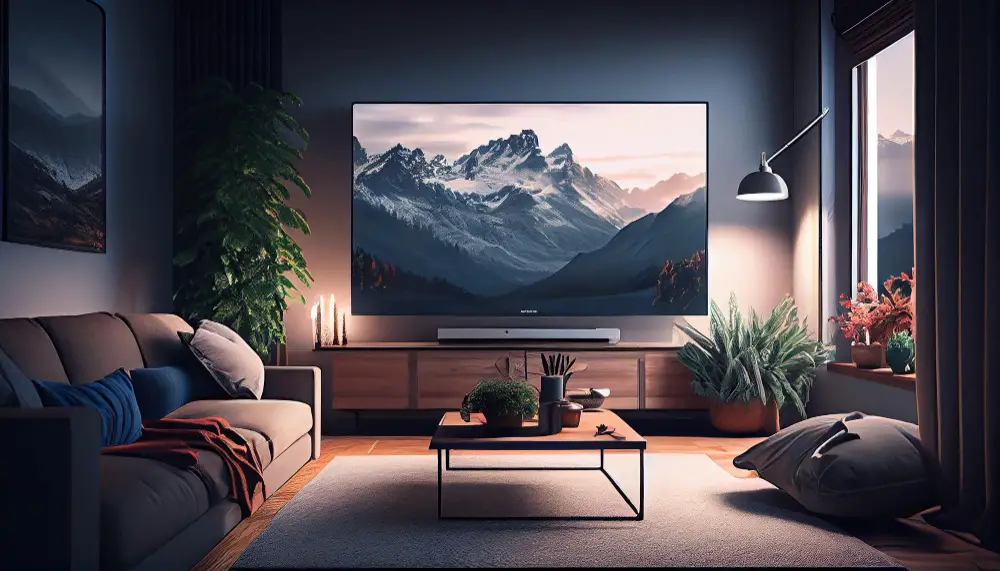High Definition (HD) offers clearer and sharper video quality than Standard Definition (SD) due to more pixels, providing a better viewing experience.
TL;DR High Definition Vs. Standard Definition
High Definition (HD) refers to video content that offers a higher resolution and enhanced picture quality compared to Standard Definition. In HD, the image is composed of a higher number of pixels, resulting in a more detailed and sharper visual experience. The aspect ratio for HD content is typically 16:9, providing a wide view that is well-suited for modern display devices.
Standard Definition (SD), on the other hand, is an older video format characterized by lower resolution and comparatively lower picture quality. The aspect ratio for SD content is usually 4:3, which was the standard for older television screens.
What is High Definition ?

Looking to dive into the world of high definition? Let’s start by unraveling what exactly high definition is all about. In this section, we’ll explore the different aspects that make up high definition, including resolution, picture quality, and aspect ratio. Get ready to discover how high definition revolutionizes the way we see and experience visual content. Get ready to be blown away by the crispness, clarity, and immersive nature of high definition.
Resolution
Resolution is an important aspect when it comes to high definition (HD) and standard definition (SD) videos. The following are key details about resolution:
- HD HD videos have a higher resolution compared to SD videos. They typically have a resolution of 1280×720 pixels (720p) or 1920×1080 pixels (1080p), providing a sharp and clear picture.
- SD SD videos, on the other hand, have a lower resolution compared to HD videos. They typically have a resolution of 720×480 pixels or 640×480 pixels, resulting in a less detailed image.
Picture Quality
When it comes to picture quality, there are several factors to consider that can greatly impact your viewing experience:
- Resolution: The resolution refers to the number of pixels in an image. HD (High Definition) offers a resolution of 1920×1080 pixels, providing sharp and detailed images. SD (Standard Definition), on the other hand, has a resolution of 720×480 pixels, resulting in a less crisp visual experience.
- Color accuracy: The color accuracy of a display is crucial for a vibrant and lifelike picture. HD technology is designed to reproduce colors more accurately, enhancing the overall picture quality. SD, on the other hand, may have limitations when it comes to color reproduction.
- Contrast ratio: The contrast ratio determines the difference between the darkest and brightest parts of an image. HD displays often have higher contrast ratios, enabling deeper blacks and brighter whites, resulting in a more dynamic and immersive picture quality. SD displays may have lower contrast ratios, leading to a less vivid image.
When choosing between HD and SD, it is important to consider your specific needs and preferences. If you value crystal-clear visuals and a more immersive experience, HD is the way to go. If picture quality is not your primary concern and you are looking for a more budget-friendly option, SD can still provide acceptable picture quality.
Aspect Ratio
The aspect ratio is an important factor to consider when comparing high definition (HD) and standard definition (SD). It refers to the proportional relationship between the width and height of an image or screen.
To understand the aspect ratio, it is helpful to refer to a table:
| Aspect Ratio | Description |
| SD (Standard Definition) | The aspect ratio of SD content is usually 4:3, which means the width is 4 units and the height is 3 units. This was the standard aspect ratio for older television sets. |
| HD (High Definition) | The aspect ratio of HD content is typically 16:9, which means the width is 16 units and the height is 9 units. This wider aspect ratio provides a more cinematic experience and is commonly used in modern televisions and screens. |
The aspect ratio affects how content is displayed on different screens. SD content with a 4:3 aspect ratio may appear stretched or have black bars on the sides when viewed on a widescreen HD display. On the other hand, HD content with a 16:9 aspect ratio will fit perfectly on an HD screen, utilizing the full width and height.
When choosing between HD and SD, it is important to consider which aspect ratio is most compatible with your viewing needs. If you prefer a wider, more immersive display, HD’s 16:9 aspect ratio is ideal. If you value compatibility with older television sets or prefer a more traditional viewing experience, SD’s 4:3 aspect ratio may be more suitable.
Understanding the aspect ratio is crucial in determining the best option for your viewing preferences and the compatibility of content with different screens.
What is Standard Definition ?

Step into the world of visual clarity as we dive into the realm of standard definition. Explore the wonders of resolution, picture quality, and aspect ratio, uncovering the secrets behind this fundamental aspect of visual technology. Brace yourself for a wild ride of facts, figures, and eye-opening events that will leave you with a newfound appreciation for the intricacies of standard definition. Get ready to delve into the realm of visual immersion like never before!
Resolution
The term “resolution” refers to the number of pixels displayed on a screen, which determines the level of detail and sharpness in an image or video. When comparing high definition (HD) and standard definition (SD), resolution plays a crucial role. Here is a breakdown of the differences in resolution between HD and SD:
- HD- HD offers a higher resolution than SD, typically at least 1280×720 pixels.
– HD displays more detailed and crisp images with smoother lines and finer textures.
– HD provides a more immersive viewing experience with vibrant and realistic visuals. - SD- SD has a lower resolution, usually around 640×480 pixels.
– SD images are often less detailed and can appear slightly blurry or pixelated.
– SD displays are more suitable for smaller screens or older devices with limited display capabilities. - Comparison:– HD offers a significantly higher resolution compared to SD, delivering superior image quality.
– SD may be sufficient for small screens or older devices, but HD provides a better viewing experience on larger screens.
Understanding the difference in resolution is essential when deciding between HD and SD. Higher resolution results in clearer, more lifelike visuals, while lower resolution may lack detail and sharpness. Consider the device or screen size and the desired level of visual quality when choosing between HD and SD formats.
Picture Quality
The quality of the picture is a crucial consideration when comparing high definition (HD) and standard definition (SD) formats. There are several key aspects to consider when evaluating the picture quality of both formats:
- Resolution: The resolution of HD is typically 1920×1080 pixels, which is higher than the 720×480 pixels of SD. As a result, HD provides sharper and more detailed images.
- Clarity: HD offers clearer picture quality due to the increased number of pixels. This results in more defined details and textures, creating a more immersive viewing experience.
- Color Depth: HD provides a wider color depth, displaying a greater range of colors. This leads to more vibrant and realistic images with smoother color gradients and transitions.
- Contrast Ratio: HD generally has a higher contrast ratio, enhancing the distinction between bright and dark areas in the image. This results in more visually appealing and dynamic visuals.
- Aspect Ratio: Both HD and SD can have different aspect ratios, such as 16:9 or 4:3. The aspect ratio affects the shape and dimensions of the image, so it’s important to choose the one that suits your viewing preferences.
When comparing the picture quality between HD and SD, it becomes evident that HD provides superior visuals with its higher resolution, clarity, color depth, and contrast ratio. These factors contribute to a more realistic and immersive viewing experience.
Aspect Ratio
The aspect ratio of a video or image refers to the proportional relationship between its width and height. It describes how the content is framed and displayed on a screen. When it comes to aspect ratio, there are two commonly used ratios: 4:3 and 16:9.
| Aspect Ratio | Description |
| 4:3 | This is the traditional aspect ratio and was commonly used in older televisions and computer monitors. It has a more square-like shape, which can sometimes result in black bars on the sides when viewing widescreen content. |
| 16:9 | This is the widescreen aspect ratio that is commonly used in modern televisions, computer monitors, and most video content. It provides a wider viewing area and is more suitable for displaying movies, TV shows, and other multimedia content. |
Aspect ratio plays a significant role in video production and viewing experiences. It determines the overall visual composition, the amount of information displayed, and the compatibility with different devices. For example, a video shot in 16:9 aspect ratio will fit perfectly on widescreen televisions without any black bars.
In the early days of television, the 4:3 aspect ratio was the standard. With the shift towards high-definition content, the 16:9 aspect ratio has become the norm due to its immersive and cinematic feel. It provides a wider field of view, allowing viewers to experience content in its intended format.
Aspect ratio is an essential aspect of video and image display. Understanding the different aspect ratios and their applications can help ensure that content is displayed correctly and optimally across various platforms and devices.
Comparison Between HD and SD
When it comes to high-definition (HD) and standard-definition (SD) content, there are key differences that can greatly impact our viewing experience. In this comparison, we’ll dive into the world of resolutions, picture quality, and aspect ratios. Get ready to uncover the captivating facts and figures behind these critical aspects of video technology, and discover how they shape our perception of visual media. So, let’s explore the intriguing world of HD and SD and shed light on the factors that define our viewing pleasure.
Resolution
Resolution is a crucial factor to consider when discussing high definition (HD) and standard definition (SD). Here is a list of important points regarding resolution:
1. HD
- – HD resolution refers to a higher number of pixels displayed on the screen compared to SD.
- – Common HD resolutions include 720p (1280 x 720 pixels) and 1080p (1920 x 1080 pixels).
- – HD resolution provides sharper and more detailed images, making it ideal for viewing on larger screens.
- – It offers a more immersive and visually satisfying experience for movies, sports, and gaming.
2. SD
- – SD resolution refers to a lower number of pixels displayed on the screen compared to HD.
- – The standard SD resolution is 480p (720 x 480 pixels) or lower, with less overall image detail.
- – SD resolution is suitable for smaller screens, such as older televisions or portable devices.
- – It offers a lower-quality visual experience, with less clarity and sharpness compared to HD.
Suggestions:
Considering the importance of resolution, it is recommended to choose a high definition option if you want optimum visual quality and a more immersive viewing experience. For smaller screens or older devices, standard definition may still provide satisfactory results. When purchasing a new television or display, it is essential to make sure it supports the desired resolution to fully enjoy high definition content.
Picture Quality
The picture quality of high definition (HD) and standard definition (SD) is a crucial factor to consider when choosing between the two. Here are some key points to understand about picture quality:
- HD offers a much higher level of detail and clarity compared to SD, making it ideal for displaying fine details and textures. The higher resolution allows for sharper images.
- SD, on the other hand, has a lower resolution resulting in less detail and clarity. The images may appear slightly blurry or pixelated, especially on larger screens.
- Both HD and SD can display a wide range of colors. However, HD provides a more accurate and vibrant color reproduction, making the colors appear richer and more lifelike.
- HD generally has a higher contrast ratio, allowing for a greater difference between the darkest blacks and the brightest whites. This results in a more dynamic and immersive viewing experience.
- Another advantage of HD is smoother motion compared to SD. This is achieved through higher frame rates, reducing motion blur and providing a more fluid display of fast-moving scenes.
It is important to note that the quality of the picture largely depends on the source material. Even with an HD display, the picture quality will be limited if the content is originally in SD. However, HD displays have the capability to upscale SD content and improve its appearance.
Aspect Ratio
The aspect ratio is a crucial factor that refers to the proportional relationship between the width and height of a display or image. It is typically expressed as a ratio, such as 16:9 or 4:3, where the first number represents the width and the second number represents the height.
The aspect ratios play a significant role in determining how content is displayed on various screens and can greatly impact the viewing experience. For instance, a wider aspect ratio like 16:9 is commonly utilized in high-definition (HD) displays, providing a more immersive viewing experience, especially for movies and widescreen content. Conversely, a more square-like aspect ratio like 4:3 is often used in standard-definition (SD) displays and is better suited for older televisions and certain types of content, such as older TV shows.
Moreover, the aspect ratio also affects the production and display of content. Filmmakers and videographers, for instance, need to consider the aspect ratio during filming and editing to ensure that the final product is correctly displayed on various screens. Similarly, when viewing content on different devices, such as TVs, laptops, or smartphones, the aspect ratio can influence how the content is displayed and whether it fills the screen or is displayed with black bars.
In summary, the aspect ratio is an essential consideration when it comes to creating, viewing, or selecting display devices. Its impact on content display and the viewing experience must not be overlooked.
Applications of HD and SD
When it comes to the applications of High Definition (HD) and Standard Definition (SD), the possibilities are endless. From television broadcasting to video streaming, both technologies have revolutionized our viewing experiences. Join me as we embark on a journey through the realms of HD and SD, exploring the captivating ways these innovations have reshaped the world of media and entertainment. Get ready to immerse yourself in the dynamic world of television broadcasting and discover the seamless wonders of video streaming.
Television Broadcasting
Television broadcasting, a vital medium for delivering television programs and other forms of entertainment, plays a crucial role in satisfying the content needs of viewers worldwide. This dynamic platform enables the transmission of a wide range of content, including television programs, news, sports, and various forms of entertainment. The quality of the broadcast is pivotal in ensuring a truly gratifying viewing experience.
When it comes to television broadcasting, high definition (HD) revolutionizes the way viewers perceive visual content. HD broadcasts elevate the viewing experience by delivering a superior level of clarity and detail compared to standard definition (SD). Typically boasting a resolution of 1920×1080 pixels, HD broadcasts bring forth sharper images and more vibrant colors, effectively enhancing the overall visual experience.
In contrast, SD broadcasts, characterized by a lower resolution of typically 720×480 pixels, offer lesser detail and poorer image quality. This reduced resolution often translates to a loss of clarity, especially when viewed on larger screens.
Beyond resolution, aspect ratio holds utmost importance in television broadcasting. HD broadcasts typically feature an aspect ratio of 16:9, creating a wider and more immersive visual experience. SD broadcasts, on the other hand, conform to an aspect ratio of 4:3, offering a different visual perspective.
Television broadcasting, be it in HD or SD, finds various applications in the media landscape. Television networks rely on broadcasting services to deliver their content to viewers through cable, satellite, or over-the-air transmission. Additionally, streaming services leverage the power of broadcasting to cater to online audiences, providing live or recorded content.
Considering both personal preferences and television capabilities, it is essential to weigh the benefits of HD and SD broadcasts. HD broadcasts, with their superior picture quality and more immersive viewing experience, stand out as the preferable choice.
Video Streaming
When it comes to video streaming, there are several important factors to consider:
- Video streaming requires a fast and reliable internet connection. To stream in high definition, a minimum speed of 5 Mbps is recommended, while standard definition requires at least 3 Mbps.
- Resolution options vary in video streaming platforms. You can choose from standard definition (480p), high definition (720p or 1080p), and even 4K Ultra HD for clearer and more detailed video quality.
- Bandwidth usage is significant when it comes to video streaming. High-definition streaming consumes more bandwidth compared to standard definition. If you have a limited data plan or share your internet connection, adjusting the streaming quality can help you avoid exceeding your data limit.
- For video streaming, you can utilize various devices such as smart TVs, streaming sticks, gaming consoles, and mobile devices. Ensure compatibility with your chosen video streaming platform and select a device that offers the desired video quality.
- When choosing a video streaming platform, consider options like Netflix, Amazon Prime Video, Hulu, and Disney+. Evaluate the content library, user interface, and supported devices before making a decision.
- Keep subscriptions and cost in mind for different video streaming platforms. The subscription requirements and costs may vary. Analyze your budget and the available content on each platform before finalizing.
- Video quality settings can be adjusted on most streaming platforms based on your internet connection speed and preferences. Optimizing the video streaming experience and minimizing buffering or lag is possible through these settings.
Frequently Asked Questions
What’s the difference between high definition (HD) and standard definition (SD) images?
The difference between HD and SD images lies in the number of pixels contained in the image on display. HD images have more pixels per square inch, allowing them to show finer detail compared to SD images.
Is the upgrade to HD quality noticeable for most people?
For the average viewer, the upgrade to HD quality may not be noticeable. Clear images are generally sufficient for most viewers, and the higher quality of an HD image may only be critical to video fanatics with high-end home theater setups.
Should I pay extra for HD videos if my device doesn’t have an HD display?
If your device doesn’t have an HD display, paying extra for HD videos may not be worth it. The extra pixels in a high-def image are not distinguishable by the human eye on a small screen, so HD is wasted on devices without HD displays.
What is video resolution and how does it impact the video’s clarity and quality?
Video resolution refers to the number of pixels contained within a frame and determines how sharp or clear the video appears. Higher resolutions, such as HD, tend to appear sharper and more professional compared to lower resolutions like SD.
What do the letters “p” and “i” stand for in video resolutions?
The letters “p” and “i” at the end of video resolutions indicate the display mode of the video. “P” stands for progressive scan, which is a newer technology resulting in a sharper-looking image, while “i” stands for interlaced scan.
What are the advantages and disadvantages of SD and HD videos?
SD videos, with lower definitions, can be advantageous for unreliable internet connections as they stream reliably without buffering. On the other hand, HD videos offer greater clarity and definition, although they require higher internet bandwidth, more storage capacity, and can impact device battery life.
Image Credits
Featured Image By – vecstock on Freepik
Image 1 By – vecstock on Freepik
Image 2 By – zlatko_plamenov on Freepik









